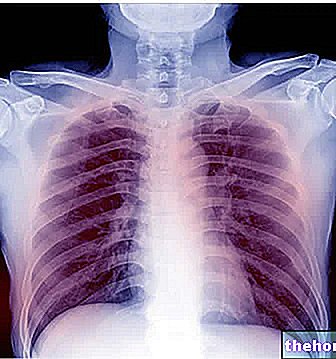1) Department of Internal Medicine, Athena Villa dei Pini Clinic, Piedimonte Matese (CE);
2) Division of Internal Medicine, A.G.P. Piedimonte Matese (CE);
3) Physiopathology, Diseases and Respiratory Rehabilitation Unit, AORN Monaldi, Naples
Generality
Bronchial asthma represents one of the most frequent affections and is characterized by a bronchial obstruction reversible.
Symptoms include:
- cough
- wheezing
- shortness of breath
- chest tightness.
These symptoms vary daily, but are prevalent at night and early in the morning.
Outline of Pathophysiology
In the presence of asthma, a "hyperreactivity of the smooth muscle occurs at the bronchial level, regulated by the action of the parasympathetic nervous system through the vagus nerve."
During bronchial inflammation, mast cells, eosinophils and T lymphocytes release chemical mediators that act directly on: muscles, glands and capillaries.

During an asthmatic crisis, the inhaled air reaches the alveoli, but the presence of bronchial obstruction prevents it from escaping with exhalation. Thus, air can enter, but cannot exit the alveoli.
Risk factors
Risk factors for asthma can be classified into:
- genetic factors
- environmental factors
The latter include all those factors that influence the development of asthma in predisposed individuals, and that cause exacerbations and / or persistent symptoms in those affected by the disease itself.
Genetic factors influencing the development of asthma
Atopy is a genetically determined predisposition to produce an excess of IgE in response to exposure to allergens, and is evidenced by the demonstration of increased serum levels of specific IgE and / or with a positive response to skin allergy tests (prik test) carried out with a battery of standardized inhalant allergens.
The proportion of asthma attributable to atopy is about half of the cases.

The manifestation of atopy has a natural history.
Atopic dermatitis usually precedes the development of allergic rhinitis and asthma. Allergic rhinitis therefore represents an important risk factor for the development of asthma. Not surprisingly, often the two pathologies coexist in the same patient and in many cases allergic rhinitis precedes the development of asthma. Another element to consider is the possible presence of wheezing (hissing that characterizes the newborn's breathing) recurrent in the first years of life. Some of these children will develop asthma.
Environmental factors influencing the development of bronchial asthma
Allergens are considered an "important cause of bronchial asthma. The increase in the incidence of asthma concerns above all the forms with a perennial course, in a considerable part of which it is possible to highlight a sensitization to indoor allergens, such as mites, derivatives of domestic animals ( cat and dog) and molds.
A meta-analysis on environmental factors considered responsible for the incidence and severity of asthma concluded that exposure to indoor allergens is the environmental factor with the strongest effect on the development of asthma.
The main allergenic sources of the external environments are pollen, derived from herbaceous and arboreal plants and mycophytes. Other agents responsible for asthma are professional sensitizers. These are responsible for 9 - 15% of asthma cases in adults. The substances most frequently involved are isocyanates, flour, grain and wood dust and latex.
Tobacco smoking plays an important role in the development of asthma and negatively affects disease control. Exposure to secondhand smoke, both pre-natal due to the mothers' smoking habit during pregnancy and during childhood, represents an important risk factor for the development of asthma in childhood and adulthood. Exposure in adulthood worsens asthma control in people with it.
Exposure to environmental pollutants is often associated with exacerbation of pre-existing asthma. The most common outdoor pollutants are: nitrogen oxides, ozone, fine particulate PM10, carbon monoxide and sulfur dioxide. They increase mainly during the winter months in cities, due to more frequent vehicular traffic, domestic heating and the favorable climatic conditions for their concentration. Modern buildings, characterized by reduced air exchange, can contribute to a greater exposure to chemical pollutants (irritating fumes and vapors) present in internal environments (indoor) deriving from the combustion of gas and detergents.
Viral airway infections have also been associated with the development of asthma. If contracted in early childhood, such as respiratory syncytial virus (RSV) infections, they frequently cause wheezing and bronchiolitis, which over the years become a factor in the development of non-allergic asthma. Viral infections in adulthood can also reveal an unrecognized bronchial reactivity and represent the onset of asthma.
There are also some pathological conditions that can facilitate the onset of asthma or favor its exacerbations.
Nasal polyposis, rhinitis, rhino-sinusitis, gastroesophageal reflux can contribute to the manifestation of asthma. The control of these diseases, therefore, also favors the control of asthma, reducing the frequency of exacerbations.
Purpose of the Treatment
The goal of asthma treatment is to achieve and maintain control of the clinical manifestations of the disease for prolonged periods.That is, meet the following points:
- No (or minimal) chronic symptom (s).
- None (or at most rare) exacerbations.
- No emergency visits or asthma hospitalization.
- No (or minimal) need for additional use of ß2 - agonists for symptom relief.
- No limitations during exercise.
- Daily change in PEF <20%.
- Normal or best possible lung function.
- No (or minimal) side effect (s) of drugs.
To achieve this, the guidelines recommend developing a care plan organized into four interrelated components:
- Sensitize the patient to develop a close collaboration relationship with the doctor.
- Identify and reduce exposure to risk factors.
- Assess, treat and monitor asthma.
- Manage an asthma flare-up.
Other articles on "Bronchial Asthma"
- Diet and Asthma
- Asthma
- Asthma - Asthma Treatment Drugs
- Bronchial Asthma - Treatment, Drugs and Prevention
- Asthmatic Crises (Asthma Attacks)
- Anti-asthmatic drugs
- Bronchial asthma - Herbal medicine




























